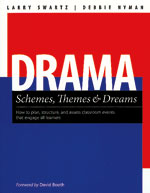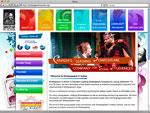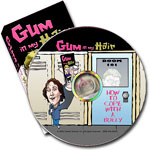Your guide to recently released books, CDs and other teaching resources. For additional reviews of French-language resources, visit Lu, vu, entendu. With the exception of some classroom sets, items reviewed are available on loan from the Margaret Wilson Library at the College. Contact Olivia Hamilton at 416-961-8800 (toll-free in Ontario 1-888-534-2222), ext 679, or e-mail library@oct.ca.
Teaching and learning, drama and movement
Digital Tools for Teaching
by Steve Johnson
Teachers know that the majority of their students are extraordinarily tech savvy, and that can be intimidating as they try to use technology with expert teenagers in their classrooms. But it is the responsibility of educators to prepare students to collaborate, create, publish and become critical thinkers using e-tools in all aspects of their lives.
This book will introduce you to some Web 2.0 resources. It’s an easy, quick read that considers the user’s comfort with technology. Blogs, wikis, word clouds, message boards, Google docs and Twitter are all covered.
The author provides a guide to the best web sites for educational uses and easy-to-follow instructions on how to use the tools.
Most importantly the book reminds teachers that the tool is less important than the content and what the teacher does with the tool. Technology may be the hook, but it is when students are creating, publishing and experimenting that their learning takes off. This is an invaluable resource for integrating digital tools into teaching.
Digital Tools for Teaching: 30 E-Tools for Collaborating, Creating, and Publishing across the Curriculum, Maupin House, Gainesville, Florida, 2010, softcover, ISBN 978-1-934338-84-1, 136 pages, US$23.95, tel 1-800-524-0634, www.maupinhouse.com
Kerry McDonald, OCT, is a Grade 7 teacher in Peterborough.
The Literacy and Numeracy Secretariat Webcast Professional Learning Series
Developed by the Ontario Ministry of Education
These three webcasts in an ongoing series of web-based resources are examples of professional development at its best.
Teaching-Learning Critical Pathways: Hubs and Networks is the case study of an urban teaching and learning network of 17 schools in Toronto. School committees are viewed in action as they discuss the evidence of student learning from their own classrooms. These committees go on to target the greatest area of student need and together, as a team, build a set of curriculum expectations to address it. Current practices are also reviewed and modified as necessary.
Today’s Learner for Tomorrow’s World focuses on integrating technology and digital literacy into the classroom. Critical literacy is stressed and demonstrated as is fostering independent learning and character development.
In Student-Led Conferences, students share their learning with their parents or caregivers. Home and school connections are strengthened as students practise becoming independent learners by using reflection and self-assessment and setting goals. References and related readings are included for future use.
The webcasts are directed at instructional professional development. Principals, program consultants, and math and literacy coaches will find them highly valuable. Theory and the practical implementation of ideas are effectively blended in each webcast. They are stellar examples of the collaboration among Ontario educators and serve as excellent models for schools to enrich their programs.
These resources (and dozens more) are available online at www.curriculum.org -> Professional Learning -> Webcasts -> Webcast Archive.
Dorothea Bryant, OCT, is a retired educator who teaches language arts to junior and intermediate teacher candidates at the University of Windsor’s Faculty of Education.
Professionalism, Law, and the Ontario Educator
by Julian Kitchen and Christopher Dean
This is a well written and highly informative resource specific to the Ontario context, with references to the Education Act, other Ontario statutes and regulations, and the Ontario College of Teachers (including examples of rulings on misconduct cases). Kitchen and Dean, both educators with a wealth of experience, cover key topics such as the legal duties and the rights of teachers, the conduct of teachers in the school and community, ensuring a safe and supportive school environment, and Special Education law. Beyond addressing all the dos and don’ts and correct procedures, the book looks at the issues at the heart of teaching as a profession grounded in an ethic of caring.
Each chapter presents interesting and controversial cases that have come before the courts. Thought-provoking questions designed to generate reflection and discussion are scattered throughout. Legal terminology is explained, complex concepts are broken down into manageable chunks and cases are cited to demonstrate how education law works in the teaching context. Practical advice is offered on how to work with stakeholders in the education system. All the information is presented clearly and concisely.
Although the book is dense, it is a truly great resource, jam-packed with pertinent information. Teachers, teacher candidates and administrators would benefit from having access to it. While few teachers would likely read it cover to cover, it would make an excellent addition to a school’s professional library.
Professionalism, Law, and the Ontario Educator, Highland Press, St. Davids, 2010, softcover, ISBN 978-0-9865873-6-0, 302 pages, $49.95, distributed by International Press Publications, tel 905-946-9588, sales@ippbooks.com, www.ippbooks.com
Sarah Frost Hunter, OCT, is an early literacy teacher for primary students with the Peel DSB.
Keen for Learning
by Edmond J. Dixon
This valuable resource shows educators how to differentiate their teaching for the multiple styles of learners in their classrooms. Based on the latest cognitive research, the premise of the text is developed through an acrostic education theory called KEEN - Kinesthetic, Endorphinal release, Experiential perspective-taking and Narrative - each of which guides teachers through lesson planning that caters to the learning needs of individual students.
Dixon’s top education priority is the creation of neural connections in the brain. His kinesthetic approach to teaching creates opportunities for movement in the classroom that releases endorphins, thereby generating the ideal conditions for knowledge acquisition. Next, Dixon advocates using experiential perspective-taking that shows students how to build imagination and long-term memory. Lastly, narrative launches new synaptic connections while students investigate and analyze questions and issues.
Practical K-12 classroom activities that employ the KEEN theory are suggested. Activities such as still life, the illustrator, event flow, brain writer and story time address the individual needs of all learners. Dixon offers a simple yet powerful framework for developing differentiated learning in your classroom.
Keen for Learning, Wintertickle Press, Barrie, 2010, softcover, ISBN 978-1-894813-53-2, 210 pages, $24.95, tel 1-800-810-9845, info@teacheasy.net, www.teacheasy.net
Chadwick Low, OCT, is an ELL/ Aboriginal academic consultant with the Dufferin-Peel Catholic DSB.
Drama Schemes, Themes and Dreams
by Larry Swartz and Debbie Nyman
During my first years of teaching drama, very few instructional books were available, and the Ministry guidelines on the subject were vague. At the time I would have paid any price for a copy of this recently published resource. In it, veteran drama teacher and consultant Larry Swartz and his equally well-qualified co-author Debbie Nyman have created a veritable Teaching Drama for Dummies help book.
The book offers comprehensive techniques and strategies for teaching drama to both the rookie and the seasoned drama teacher. The suggested projects are complete, removing the need for teachers to spend hours researching and planning lessons. The activities - suggested by classroom teachers and actors - are varied and current and make use of e-tools like blogs and e-mails. The best proof of success is how well an activity works. I have tried several in drama classes for Grades 1 through 10 and found that the activities did indeed engage all learners, as promised.
New and experienced teachers will find this a highly useful text. If I could have only one strategy book for drama, this would be it.
Drama Schemes, Themes and Dreams: How to Plan, Structure, and Assess Classroom Events That Engage All Learners, Pembroke Publishers, Markham, 2010, softcover, ISBN 9781551382531, 160 pages, $24.95, tel 905-477-0650 or 1-800-997-9807, www.pembrokepublishers.com
Gail Lennon is a writer and reviewer with more than 35 years of teaching experience at all levels.
Shakespeare in Action
Shakespeare in Action is a multiracial Shakespearean theatre company designed to appeal to young audiences. The company itself is in residence at Central Commerce Collegiate in Toronto, but it is the web site that is of particular interest to Ontario teachers. Shakespeareinaction.org is a visually attractive, extremely well-organized and friendly site that allows users to peruse various listings, events, programs and festivals and to make bookings online.The site includes a virtual lab for both educators and students, with information about summer acting camps and community programs like a Shakespeare club for kids run at 30 branches of the Toronto Public Library. It also offers detailed information about the National Shakespeare Youth Festival and performing arts schools. Accompanying videos support most of the information.
The company is an exciting new multicultural group of interdisciplinary artists who reflect Toronto’s diverse community. Canadian interpretations of Shakespeare and other contemporary stories relevant to young audiences are part of its repertoire. The web site provides easy access to all opportunities offered by the company along with downloads of registration forms and seasonal brochures.
Visit www.shakespeareinaction.org.
Majella Atkinson, OCT, is a Grade 8 teacher at St. Pius X School in Toronto.
Moving and Growing
Developed by the Canadian Institute of Child Health and the Canadian Child Care Federation
Children need to be active, but finding fun ways to incorporate activity into their daily lives can be challenging for teachers. The Moving and Growing series of books is a valuable collection of information and activities that promotes the healthy physical development of children. The books follow developmental stages, highlighting physical and motor development but also discussing the evolution of self-esteem and ideas to foster lifelong healthful habits and wellness.
Originally published in 1984-87 - and updated in 2004 with extensive research-based information - the series is still relevant, given our progressively more sedentary culture and the worrisome rise in child obesity. The books are well-designed and have easy-to-find ideas and activities to integrate into the school days - one-on-one activities, motor-development activities and games for all group sizes.
Each of the three books focuses on a different age group - nursery school, kindergarten and early primary-age children. Major skills and movements are identified and modifications suggested for children with special needs. Safety precautions are given along with a list of additional resources.
Encouraging children to develop healthy lifestyle choices is more critical than ever, and this is a wonderful addition to the teacher’s toolbox.
Moving and Growing I: Exercises and Activities for the First Two Years, ISBN 0-919747-65-5, 104 pages / II: Exercises and Activities for Twos, Threes and Fours, ISBN 0-919747-67-1, 96 pages / III: Exercises and Activities for Fives and Sixes, ISBN 0-919747-69-8, 96 pages / Canadian Institute of Child Health, Ottawa, 2004, softcover, each $10.00, series of three $27.00, tel 613-230-8838, publications@cich.ca, www.cich.ca (mention Professionally Speaking on the order form for a 40% discount)
Janet Cottreau, OCT, is an occasional elementary school teacher with the Ottawa-Carlton DSB.
Gum in My Hair! and The Wild Wild Web (DVDs)
Produced by Twisted Scholar
Both of these DVDs take direct aim at school bullies - the first targeting those who attack in the school environment and the second targeting cyber bullies.
Gum in My Hair! features scenarios that teach students (ages 8-14) how to respond to the bullies in their classrooms and schoolyards. The 20-minute DVD comes with an excellent study and discussion guide with ideas for preparing students before, during and after viewing. It proposes ways to use the DVD across the curriculum and suggests questions to enrich discussion. Tips for parents are included, extending the possibility of using the resource on curriculum night.
The Wild Wild Web stresses three critical lessons about cyber bullying: if you can’t say it to their face don’t say it in cyberspace; break the chain of rumour and innuendo; and tell someone if you are being bullied online. The 26-minute DVD presents a real cyber-bullying case, showing that the story is not only about the bully and the bullied but about the whole cyber community in chat rooms and Facebook interactions. The program and discussion guide suggest lesson plans and ideas for cross-curricular connections.
These resources support teachers in delivering a powerful message - bullies will not be tolerated, and a student is never alone if he or she is bullied. I recommend them both.
Gum in My Hair!: How to Cope with a Bully, 2003, 20 minutes, US$49.95 / The Wild Wild Web: A Student’s Guide to Preventing Cyber Bullying, 2011, 26 minutes, US$69.95 / Twisted Scholar, Seattle, info@twistedscholar.com, www.twistedscholar.com
Dorothea Bryant, OCT, is a retired educator who teaches language arts to junior and intermediate teacher candidates at the University of Windsor Faculty of Education.
Words That Start with B
by Vikki VanSickle
Bullies, best friends, breast cancer and bravery - those are the B words that are the focus of Clarissa Delaney’s Grade 7 life in southwestern Ontario. Clarissa is not tall or big, but she has confidence in herself, and that is why her best friend Benji admires her. Her strength, her mental bravery and her fierce sense of justice help her to face her mother’s diagnosis of breast cancer. Those same attributes also help convict the homophobic bully who puts Benji in the hospital. Clarissa’s courage in standing up for what is right, even when it is not popular (even when it is dangerous), make her an admirable intermediate hero in a book that should elicit rich avenues for discussion in class.
Clarissa’s teacher continues to ignore the telltale signs of bullying - the snickers, the name-calling, the bruises, the fading personalities, the absences and even the hate literature posted on the victim’s locker. Benji’s father, a popular local sports hero, does no better. He insists on enrolling his son in sports rather than allowing Benji to focus on his strengths in design and aesthetics. Clarissa, who knows all about her best friend being bullied, does not talk to the adults because she can’t trust the outcome.
Those issues are charged with teaching possibilities. What do you do when you know that someone is being bullied? How can you help without hurting either the victim or yourself? Whom can you trust? Although kids should be able to trust the adults in their lives to help, this has not been the experience of many children. These are relevant topics for students to explore in the safety of their own classrooms, even in 2011!
Words That Start with B, Scholastic Canada, Toronto, 2010, softcover, ISBN 978-1-4431-0235-3, 208 pages, $8.99 ($4.99 through Scholastic Book Club), tel 905-887-7323 or 1-800-268-3860, custserve@scholastic.ca, www.scholastic.ca
Kara Smith, OCT, creates curricula for the Faculty of Education at the University of Windsor and for the Lambton Kent DSB.
Half Brother
by Kenneth Oppel
In 1973 Ben’s scientist parents moved across the county to Victoria to conduct a novel experiment. With them was an eight-day-old chimp who would be raised as Ben’s brother. Their goal was to find out whether chimps can learn language. The experiment completely altered teenage Ben’s life.
The book covers the unexpected consequences of bringing a chimp into a family and teaching him sign language. Ben’s father regards the chimp, Zan, as an experiment, whereas Ben ends up bonding deeply with him - and that inevitably leads to conflict, especially as Ben begins to discover girls. The language experiments and Zan’s reactions to them are fascinating and lead to questions about what becomes of Zan when the experiment is over. Ben can’t simply forget Zan, and this compels him to make a tough decision. How far do you go for love?
Half Brother is suitable for middle schoolers and up. Although it is a fairly easy read, it raises complex moral issues involving animal experimentation, including questions such as what makes us uniquely human and what are the distinctive components of language. It could even lead to an examination of the 1970s (the book describes the era in detail, complete with shag rugs) as well as universal teenage issues. This is an excellent read that reflects the empathy Kenneth Oppel brings to the fictional animals he writes about in his other books.
Half Brother, HarperCollins Canada, Toronto, 2010, hardcover, ISBN 9781554688128, 304 pages, $19.99, tel 416-321-2241 or 1-800-387-0117, www.harpercollins.ca
Rosemarie Chapman is a retired teacher with the Hamilton-Wentworth Board of Education.
Thunder over Kandahar
by Sharon E. McKay, photographs by Rafal Gerszak
Fourteen-year-old Yasmine can’t believe that her parents have decided to move their family back to their homeland. She misses everything about her life in Oxford, England and desperately hates the chaos and terror in Afghanistan. While she understands that in Afghanistan her father can teach at the university and her mother can practise law, it is not her home and she wants her old life back.
When her mother is brutally attacked by the Taliban and her father is threatened, their first instinct is to return to their life in the West, but then they reconsider and decide that it’s more important than ever to stay and work in their country. Yasmine is distraught and depressed until she meets Tamanna - a teenager in their village. The girls instantly bond and become inseparable friends. They are thrilled when they are allowed to attend school. However, their happiness ends abruptly when the Taliban burns down the school, attacks the teacher and threatens the girls with death.
This is just the beginning of a riveting and suspenseful story. Told from the alternating viewpoints of the two girls, the novel takes a hard look at the North American military presence in Afghanistan and offers a glimpse of the sacrifices Afghanis have made so that their love and vision for their country can endure. This book is an essential read for students in Grade 7 and up.
Thunder Over Kandahar, Annick Press, Toronto, 2010, softcover, ISBN 9781554512669, 264 pages, $12.95, distributed by Firefly Books, tel 416-499-8412 or 1-800-387-6192, service@fireflybooks.com, www.fireflybooks.com
Nadira Baksh, OCT, is pursuing Additional Qualifications in library studies while on parental leave from the classroom.
Référentiel grammatical, 7e–8e année
from the Tours de piste collection by CFORP (Centre franco-ontarien de ressources pédagogiques)
I have always had a passion for linguistics, and as a high school teacher who sometimes wonders where to begin with Grade 9 students whose knowledge and skills vary so widely from one school to another, I set about reading this with keen interest.
I did not so much read the book as go over it with a fine-tooth comb, page by page. And I was both delighted and disappointed. Delighted because I kept telling myself that if students already possessed this knowledge when they came to us, our task at the secondary level would be only too easy. Disappointed because I realized that the level of abstraction in this work does not match the level of a Grade 7 or 8 student - the very readership it targets.
While Référentiel grammatical is a concise linguistic treatise, it discusses the notions of semantics and morphosyntax. We need to ask ourselves: To what extent is this abstraction a goal of language teaching, particularly when it comes to 12- and 13-year-olds?
That said, I was quite charmed by the work’s so-called “new” approach and greatly appreciated the connection it makes between the various syntactical, morphological and semantic criteria in order to describe the nature of a word. I was reminded of the approach used by Gustave Guillaume, whose concepts have always struck me as very modern. Everything seems to be connected, with the simplest things dovetailing into the most complex, which then turn out to be simple as well.
Some of the concrete ideas in this work can certainly be applied in the classroom. The ones I really liked include:
- paying attention to errors and using them as a source of learning, since errors also show the regularities of language
- the overview of periphrasis in part three, Text Grammar, which seems very important for language acquisition
- language levels
- the various types of texts, each of which is described very clearly.
In short, this work is well executed and teachers will find it interesting to consult. Students, on the other hand, will lose their way; it should perhaps come with a workbook providing more concrete exercises.
Référentiel grammatical, Éditions CFORP, Ottawa, 2010, softcover, ISBN 9782895816645, 100 pages, $19.95, tel 613-747-1553 or 1-877-747-8003, commandes@librairieducentre.com, www.librairieducentre.com
Vera Nochtéva, OCT, is a French teacher at White Oaks SS in Oakville.











